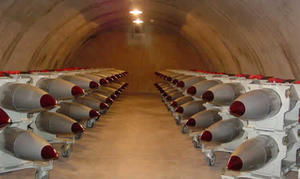Nuclear weaponsU.S. nuclear arsenal must be upgraded to maintain effective deterrence: Experts
Former military officers, academic strategists, scientists, and congressional leaders have recently been calling for the development of new nuclear weapons to replace the nation’s older, outdated stockpiles. Twenty-five years since the cold war ended, the U.S. nuclear arsenal has been significantly reduced to its current level of 4,804 nuclear weapons — from a peak of 31,000 weapons in 1967.As cooperation with Russia deepened in the 1990s, U.S. weapons complexes deteriorated. A recent “60 Minutes” story on the U.S. nuclear forces found that missileers charged with watching over and controlling Minuteman III ICBMs in Wyoming were still using floppy disks to store critical information. One expert arguing for shoring up and upgrading the U.S. nuclear deterrence says that “one of the reasons deterrence is so valuable is that it provides incentives for self-discipline in the behavior of states that otherwise cannot be trusted to behave peaceably.”

Aging U.S. nuclear weapons in storage bunker // Source: presstv.ir
Former military officers, academic strategists, scientists, and congressional leaders have recently been calling for the development of new nuclear weapons to replace the nation’s older, outdated stockpiles. “We should get rid of our existing warheads and develop a new warhead that we would test to detonation,” said John Hamre, deputy secretary of defense in the Clinton administration and now president of the Center for Strategic and International Studies (CSIS). “We have the worst of all worlds: older weapons and large inventories that we are retaining because we are worried about their reliability.”
Roughly twenty-five years since the cold war ended, the U.S. nuclear arsenal has been significantly reduced to its current level of 4,804 nuclear weapons — from a peak of 31,000 weapons in 1967. The United States agreed to an international moratorium on testing new nuclear weapons shortly after the Soviet Union fell in 1991, though it never ratified the Comprehensive Nuclear-Test-Ban Treaty (CTBT), which bans all nuclear explosions in all environments, including underground testing, for military or civilian purposes. A ban on underground tests was considered a crucial step toward full nuclear disarmament because it would serve as a barrier against developing new weapons.
As cooperation with Russia deepened in the 1990s, U.S. weapons complexes deteriorated. The Los Angeles Times reports that at the Pantex facility in Texas, where nuclear weapons are disassembled and repaired, employees work in an environment suffering from rat infestation. “They literally have to keep their lunch bags on a shelf that’s head high so it won’t get eaten,” said Representative Mac Thornberry (R-Texas), chairman-elect of the House Armed Services Committee. “They find them on their computers, in the hallways. It’s a continual problem.”
Even some of the buildings at the Y-12 National Security Complex in Oak Ridge, Tennessee are falling apart. In March, an eight-foot-section of the concrete ceiling at Y-12’s Beta-2 facility collapsed. “It seems like common sense to me if you’re trying to keep an aging machine alive that’s well past its design life, then you’re treading on thin ice,” said Thornberry. “Not to mention, we’re spending more and more to keep these things going.” A significant amount of money is currently spent on maintaining and storing outdated nuclear weapons. A 2012 study by the Stimson Center estimated costs would be at least $352 billion over the coming decade to operate and modernize the current arsenal.
The Obama administration’s plan to spend $60 billion to modernize the Y-12 complex and update weapons includes designing a new type of warhead built with components from older weapons. The device, called the interoperable warhead, would combine an atomic trigger from one weapon with a thermonuclear assembly from another. Proponents of nuclear disarmament oppose the idea. “Mixing and mashing parts into configurations that have never been tested before is not a good idea, by any means,” said Kingston Reif, director for disarmament and threat reduction policy at the Arms Control Association. “It’s going to cost money that we don’t have for a mission that plays an increasingly limited role in U.S. national security.” Philip Coyle, a former deputy director of the Lawrence Livermore National Laboratory and until 2011, served as associate director for national security and international affairs in the White House Office of Science and Technology Policy, said developing the interoperable warhead violates the Obama administration’s pledge against developing new nuclear weapons. “It sends the wrong message to the rest of the world,” he said.
John S. Foster Jr., the former head of the Lawrence Livermore National Laboratory (1961-65) and then director of the Pentagon’s Defense Research and Engineering (1965-73) supportsmaintaining and improving U.S. nuclear capabilities for deterrence, and has also called for new weapons systems that may be needed by the military of the future, including an electromagnetic pulse weapon that could destroy targeted communications systems, and a penetrating weapon to destroy deeply buried targets. “After more than two decades, the nuclear deterrent could be in worse shape than we want to believe,” Foster said. “We need to demonstrate the proficiency of our weapons labs and our strategic forces.” In a 2007 article for the American Physical Society, Foster links the importance of a strong U.S. nuclear arsenal to national security. “The value of effective deterrence did not end with the Cold War; it remains essential to national security, and nuclear weapons remain essential to effective deterrence.” He added that “one of the reasons deterrence is so valuable is that it provides incentives for self-discipline in the behavior of states that otherwise cannot be trusted to behave peaceably.”
— Read more in Russell Rumbaugh and Nathan Cohen, Resolving Ambiguity: Costing Nuclear Weapons (Stimson Center, 17 September 2012)
